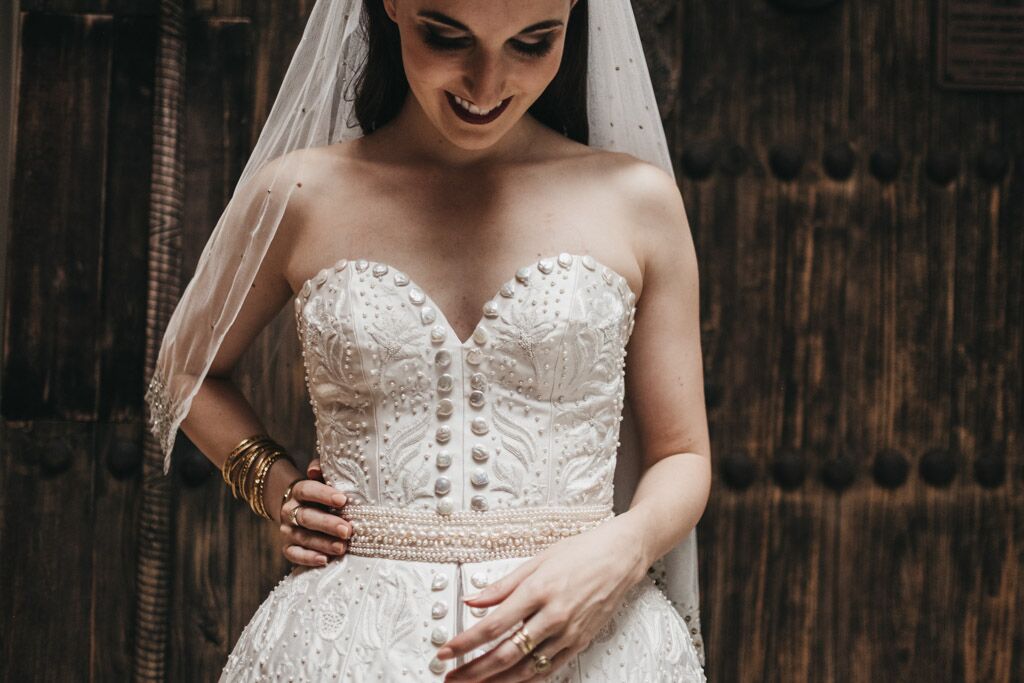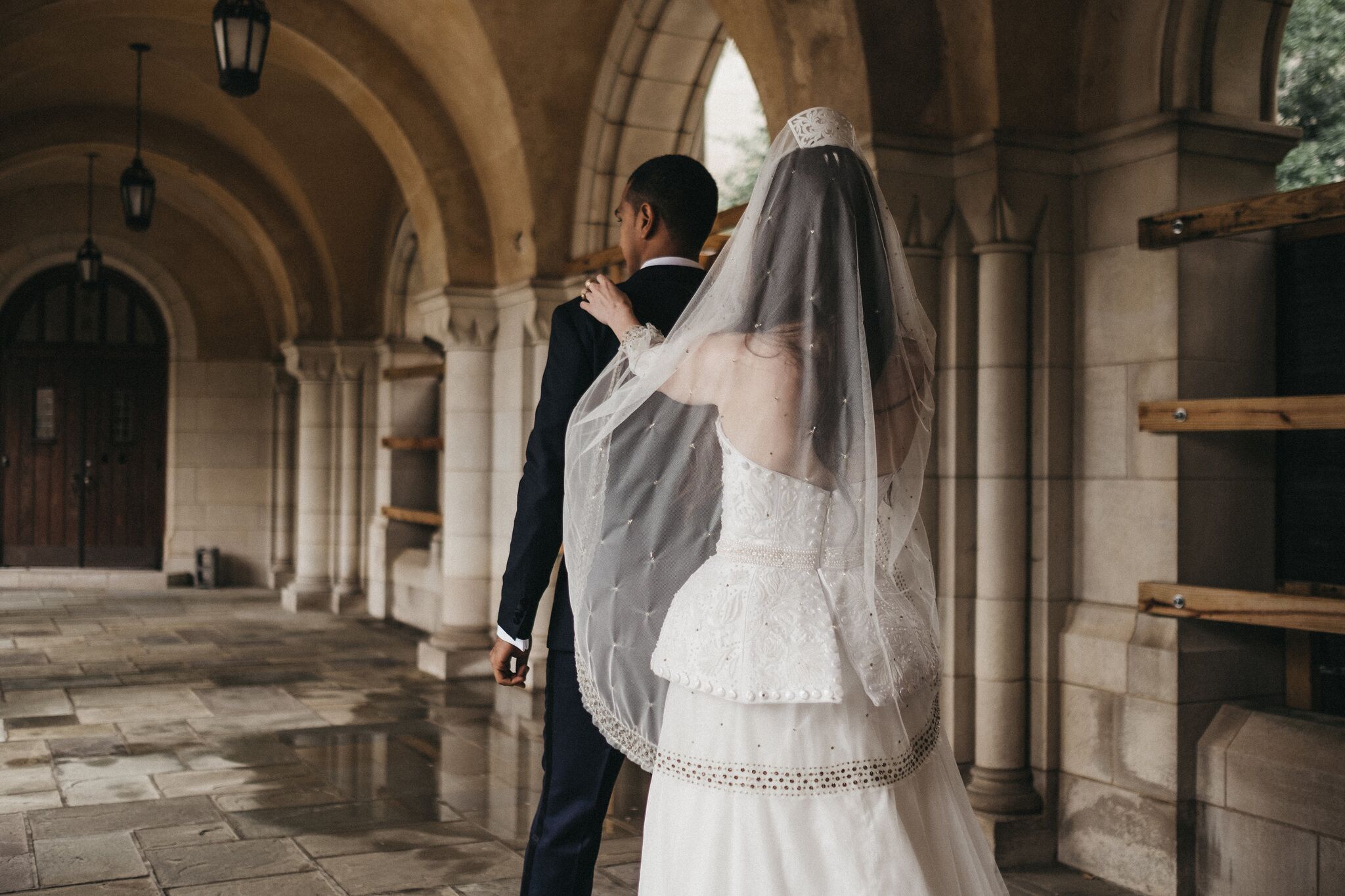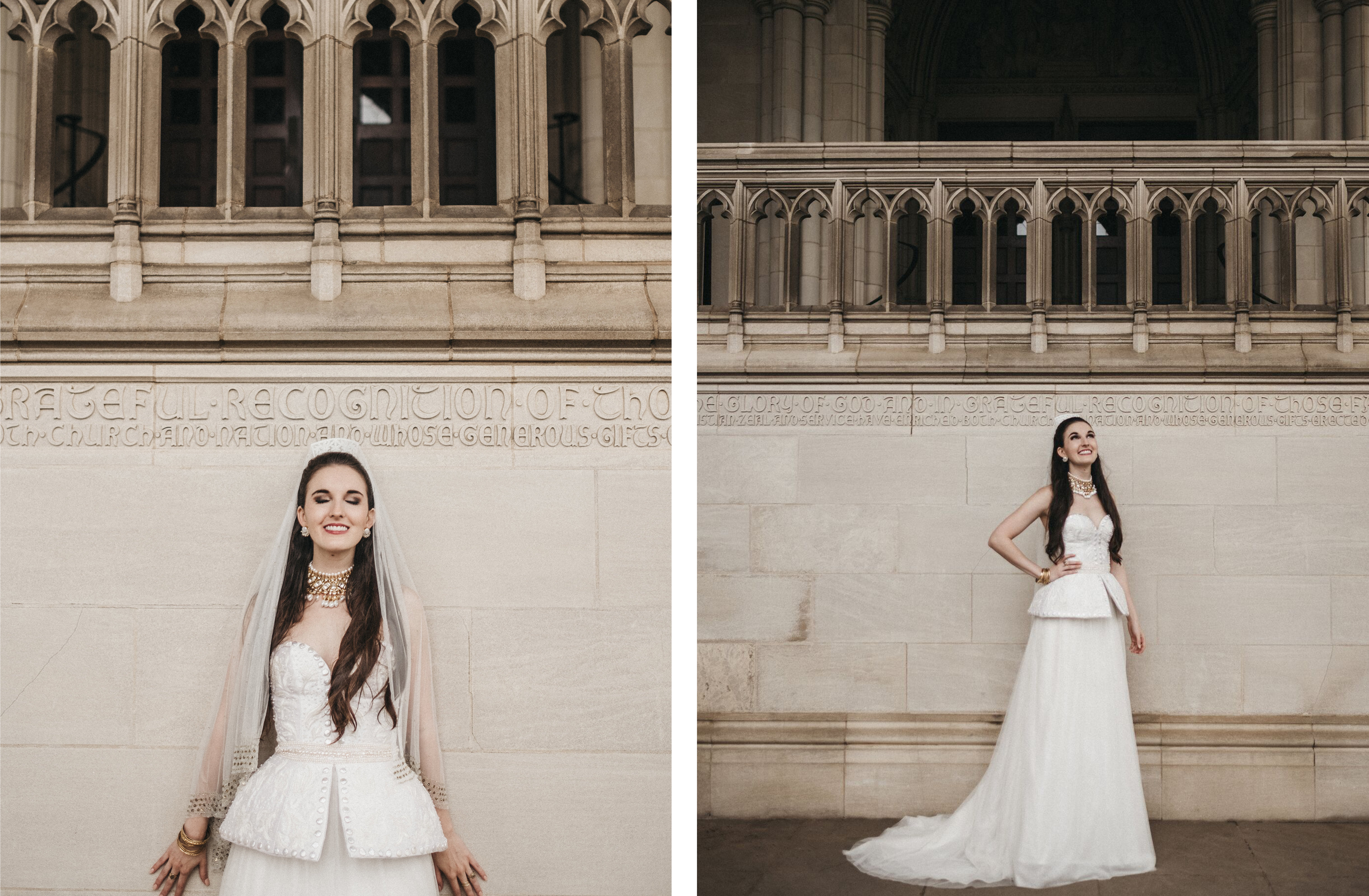
Throughout time and across cultures, there are few garments with more ceremonial significance than a wedding dress. I’ve always been interested in ceremonial dress, and the way that a simple garment can become part of the experience of a ritual, carrying with it our most personal hopes and dreams, the story of our family and culture, and commemorating the sacred things in our lives.
In anticipation of my own wedding, I spent a weekend gathering my favorite inspiration images and sketching up a storm, taking over my living room with dozens of rough sketches flying everywhere. I ended up sending out five final designs to my close friends to help me decide on the winner. We settled on this shape, a strapless gown with a fitted bodice and a flowing tulle skirt. The first consideration in any custom gown is creating a flattering silhouette for your figure. For me, this meant emphasizing my natural waist with a fitted bodice and a structural peplum. And since embroidery is one of my favorite things in the world, the gown was not bound to go unadorned!
 Studio sketches of the gown and watercolor detail of embroidery layout
Studio sketches of the gown and watercolor detail of embroidery layout
For the embroidery design, I decided that I wanted a lush and flowing all-over embroidery on the bodice, but toned down by an all-white palette. My points of inspiration were my husband’s mother’s most loved Indian flower, the star pointed jasmine, as well as favorite alabaster white florals from Mughal carvings at the Taj Mahal. When it came to the stones, natural freshwater pearls have always been a favorite in my mother’s family: my mom grew up skin-diving in the Arabian Sea, dredging up gorgeous natural pearls from the sandy depths. As a nod to this tradition, all the women in her family wear the same simple pearl-and-gold-wire earrings that her aunt Marguerite had made in Tangier for the whole family. When I think about classic beauty, I think of natural organic pearls. So I decided to use flat coin freshwater pearls as an edge motif recalling the repeated studding on Arabian wooden doors, and scatter miniature seed pearls throughout the embroidery. The bodice was finished with a delicate belt composed of tiny pearls in rows.
As for my veil, I knew I wanted a small mantilla, since I’ve always loved the drama and height of a great hair comb. After too many episodes of “The Handmaid’s Tale” spent scouring for combs online I landed on a beautiful white cellulose carved Spanish comb from the 1960’s. I decided to do a simple tulle veil with a touch of gold embroidery at the hem, incorporating antique gold sequins and using one of my favorite traditional Indian techniques, folded metalwork, where artisans take tiny strips of metal and fold them into the latticework of tulle. This little touch of gold offset the gold jewelry that I was designing for the wedding and the gold vintage Christian Louboutins which would peek out from under my dress.

With all the designs decided, I worked with a master pattern maker in New York to create the toiles for the dress. We had three fittings to finalize the fit, volume, and materials of the dress. We settled on a heavy silk mikado for the bodice and a silk-effect tulle for the skirt and veil. The inner structure is important to a gown’s fit and movement with the body, so we created a traditional boned satin bustier in the bodice and a slim net petticoat for the skirt. As a finishing touch I prepared two small fabric tags, one hand-embroidered with our wedding date and initials, and another as a little joke for my husband, printed with a favorite baby picture of him in a blue onesie, as my “something blue”to be sewn into the lining. In terms of bustling the dress up for dancing, I wasn’t too concerned about the long skirt because I had an afterparty look in the works to the tune of gold sequin disco pants!
 Toile fitting with our master patternmaker in his studio
Toile fitting with our master patternmaker in his studio
So once the patterns were finalized, we sent the fabric off to be embroidered with our artisan partners in India. While most brides order their gowns months in advance, as the designer I was able to be more last-minute, yet I was still feeling confident on timing with about 6 weeks until the wedding. That said, when we opened up the embroidery panels package from India, a few areas were not completed entirely. So we packaged it all up and sent it back, where the artisans carefully filled in certain areas and made sure the work was perfect. There was still time left to sew the gown with our brilliant sewists in New York when disaster struck — natural disaster that is. With now 2 weeks until the wedding, the rains came in India, deluging Mumbai with pouring monsoons and prohibiting flights out for 10 days. My blood pressure was somewhat elevated and here we were, 4 days before the wedding and my wedding dress was stuck in India, unassembled. Due to some stroke of luck or perhaps the Goddess of International Embroidery to whom I now owe my soul, the panels arrived in New York 2 days before the wedding. Our wonderful sewing team, having prepared everything they could in advance, scrubbed in at the eleventh hour, and carefully inserted the final pieces into the gown. My truly dedicated studio assistant hand-carried the gown to my childhood home, and it was in my hands just after midnight the night before the wedding.


A word to the wise… what can go wrong will go wrong, and do not let the fate of your wedding dress hang on the mercies of Indian tempests! But in the end I felt incredibly lucky that everything worked out beautifully with the help of many talented hands. And the morning of my wedding, I put on my wedding dress with the satisfaction of having created something thoughtfully made, personally resonant, and uniquely beautiful to step into this very happy day.





Photography: A Fist Full of Bolts
and when you appear all the rivers sound in my body, bells shake the sky, and a hymn fills the world.
PABLO NERUDA
Hi, this is a comment.
To get started with moderating, editing, and deleting comments, please visit the Comments screen in the dashboard.
Commenter avatars come from Gravatar.